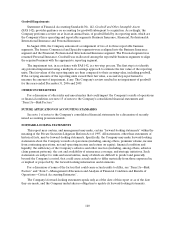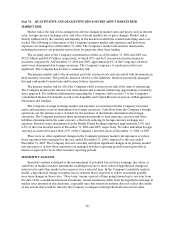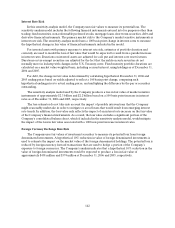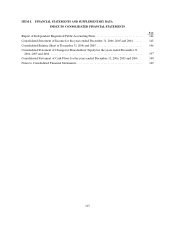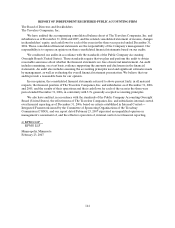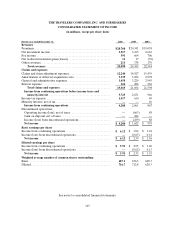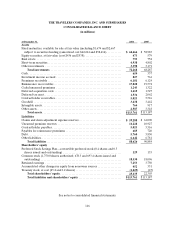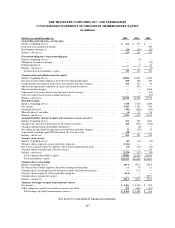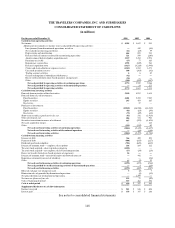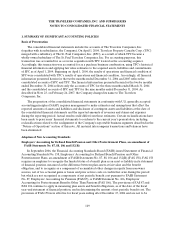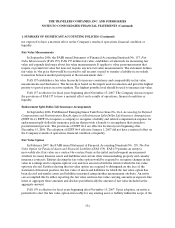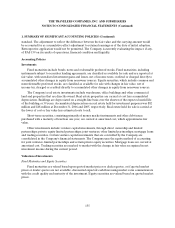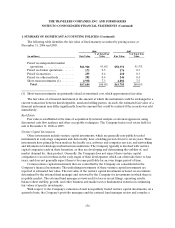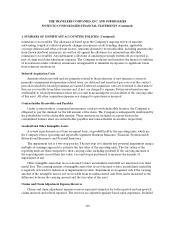Travelers 2006 Annual Report Download - page 162
Download and view the complete annual report
Please find page 162 of the 2006 Travelers annual report below. You can navigate through the pages in the report by either clicking on the pages listed below, or by using the keyword search tool below to find specific information within the annual report.THE TRAVELERS COMPANIES, INC. AND SUBSIDIARIES
NOTES TO CONSOLIDATED FINANCIAL STATEMENTS (Continued)
150
1. SUMMARY OF SIGNIFICANT ACCOUNTING POLICIES (Continued)
applied retrospectively. The Company’s adoption of FAS 158 at December 31, 2006 resulted in an $80
million reduction, net of tax, to shareholders’ equity and is recognized as an adjustment to the ending
balance of accumulated other changes in equity from nonowner sources. The adoption of FAS 158 didnot
affect the Company’s results of operations or liquidity as FAS 158 does not affect the determination of net
periodic pension cost. See note 12.
Considering the Effects of Prior Year Misstatements when Quantifying Misstatements in Current Year
Financial Statements
In September 2006, the staff of the Securities and Exchange Commission (SEC) issuedStaff
Accounting Bulletin No. 108, Considering the Effects of Prior Year Misstatements when Quantifying
Misstatements in Current Year Financial Statements (SAB 108), as an interpretation by the SEC staff of the
process of quantifying financial statement misstatements for purposes of determining whether a
misstatement is material. SAB 108 was issued to address diversity in practice used by registrants in
quantifying financial statementmisstatements, and the potential under the current practice for the build up
of improper amounts on the balance sheet. SAB 108 requires registrants to quantify the impact of
correcting all misstatements, including both the carryover and reversing effects of prior year statements, on
the current year financial statements (i.e., the income statement and the balance sheet). Staff Accounting
Bulletin No. 99, Materiality, which requires that both qualitative and quantitative factors be evaluated in
determining whether a misstatement is material to the financial statements, is not affected by the issuance
of SAB 108.
SAB 108 was effective for the first interim period of the first fiscal year ending after November 15,
2006, with early adoption encouraged. The adoption of SAB 108 at December 31, 2006 had no effect on
the Company’s results of operations, financial condition or liquidity.
Share-Based Payment
In December 2004, the FASB issued Revised Statementof Financial Accounting Standards No. 123,
Share-Based Payment (FAS123R), an amendment to FAS 123, Accounting for Stock-Based Compensation,
and a replacement of Accounting Principles Board Opinion No. 25, Accounting for Stock Issued to
Employees, and its related implementation guidance. FAS 123R requires public entities to measure the cost
of employee services received in exchange for an award of equity instruments based on the grant-date fair
value of the award and to recognize that cost over the requisite service period.
FAS 123R, which became effective January 1, 2006, requires entities that use the fair-value method of
either recognition or disclosure under FAS123 to apply a modified version of the prospective application.
Under modified prospective application, compensation cost is recognized on or after the effective date for
all unvested awards, based on their grant-date fair value as calculated under FAS 123 for either recognition
or pro forma disclosure purposes.
In addition, the accounting for certain grants of equity awards to individuals who are retirement-
eligible on the date of grant has been clarified. FAS 123R states that an employee’sshare-based award
becomes vested, for expensing purposes, at the date that the employee’s right to receive or retain equity
shares is no longer contingent on the satisfaction of a market, performance or service condition.
Accordingly, awards granted to retirement-eligible employees are not contingent on satisfying a service
condition andtherefore are recognized at fair value on the date of the grant. Additionally, the period over


